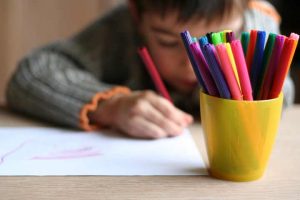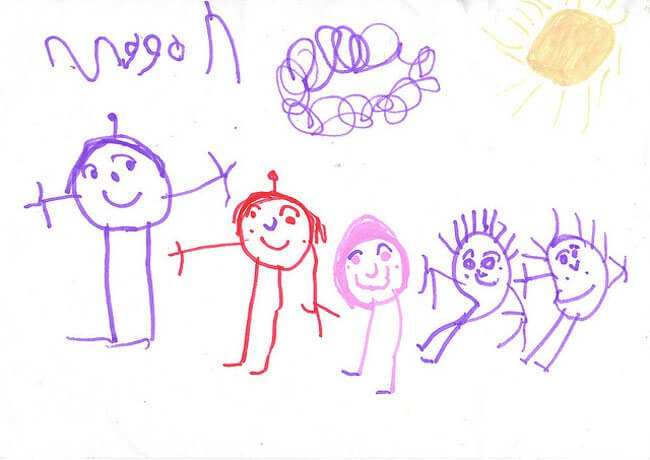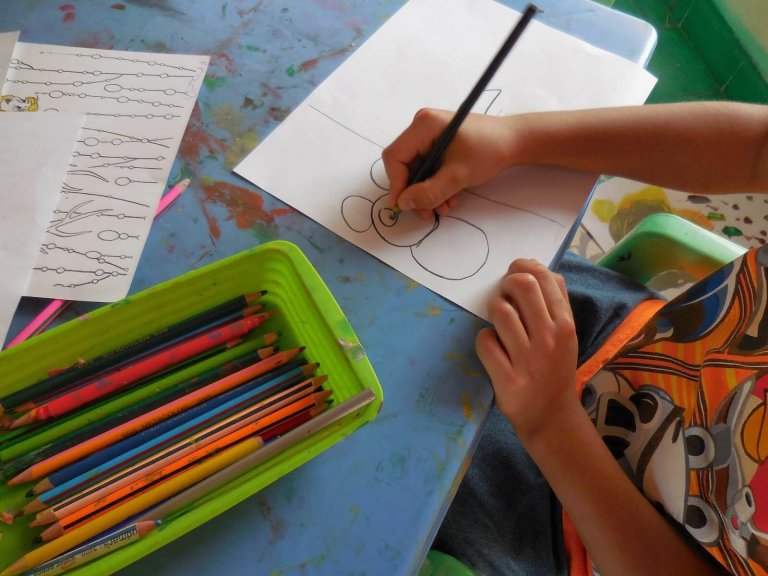What Are Your Children's Drawings Telling You?

From the very first scribbles to more complex artwork, children’s drawings reflect features of their personality, their fears, emotions and the way they see the world.
But what are your children’s drawings telling you? In this article, we’ll help you interpret them.
The stages of children’s drawings
One year old
At this age, children don’t yet have the intention or ability to represent shapes, figures or objects in their drawings.
Even so, you may be able to explore some early signs of your child’s temperament and emotional state.
Two years old
By the time they’re two years old, children are generally able to give more shape to their scribbles. These are no longer disconnected lines: you’ll be able to see shapes and outlines.
These may be your child’s first attempts to draw objects from real life, and to experiment with different colors.
Three years old
At this stage, you’ll begin to notice shapes that are identifiable as objects or people.
By three years of age, children’s drawings may show clear attempts to portray situations, characters and emotions.
The child’s first sketches of the human figure appear, along with many other shapes.
Five years old

By this time, your child’s cognitive structures have had time to mature. Your child’s artwork will be just one way of appreciating how much progress they’ve made.
The human figure should be perfectly identifiable, and will have most of the following key elements: head, body, upper and lower limbs.
Another important aspect that appears at around this time is differentiation.
This means that, when your child paints various people in a picture, each one of them will have different features that set them apart.
This detail is an important sign of creativity and the ability to observe the environment.
Six years old
From this age onwards, your child’s drawing style will be more consolidated. Artwork is just another tool for communication.
Drawing is a creative outlet that allows the child to reflect the complex mosaic of sensations and emotions inside their head.
As such, your child’s artwork can become an important window into the inner workings of their mind.
Now, human figures and objects interact on the page. Your child should be able to draw items not just individually but also as part of a scene or specific situation.
What are your children’s drawings telling you?

Children’s drawings contain some clues that can help parents understand what is going on in their minds.
However, it’s important to bear in mind that this isn’t an exact science. The main aspects to look out for are:
How your child holds the pencil
One of the main things to look for is how your child holds the crayon or pencil in their fingers.
A loose hold on the pencil may mean that the child is relaxed, while a tight grip indicates tension or nervousness.
The size of the drawings
The size of each drawing may relate to the child’s tendency towards extroversion or introversion.
Children who are timid, with low self-esteem, tend to produce small drawings. Those who are more upbeat and outgoing will cover over half the sheet of paper.
Direction of drawings
Normally, drawing towards the left of the page denotes introversion and distance, while drawing towards the right is a sign of communication and extroversion.
Placement of drawings
If the drawing is at the top of the page, this can reflect a tendency to fantasize.
Children who draw from the bottom of the page, meanwhile, tend to need security and be realistic in their thinking.
Drawings on the right of the page are typical of extroverted children who look towards the future, while the left of the page denotes introversion or inhibition.
Children who draw in the very center of the page display good self-control, and are realistic and objective.
Type of lines
- Pressure: if the child is pressing down hard on the pencil or crayon, this may be a sign of aggression or impulsiveness. A very faint line can show shyness or inhibition.
- Form: straight lines are typical of aggressive personalities, although they also show that the child has control over their emotions. Curved lines are a sign of softer, sweeter character.
- Continuity: When lines are broken, this may indicate insecurity or difficulty relating to others. When lines are continuous, this shows that the child feels secure and outgoing, and has no problems socializing.
“All children are born artists, the problem is to remain an artist as we grow up”
-Pablo Picasso-
Shading
This is a technique that some experts interpret as a sign of distress or anxiety in children’s drawings.
Erasing
When the child frequently erases what they’ve drawn, this is a sign of insecurity.
Symmetry
A lack of symmetry may show that the child feels insecure or doesn’t fit in.
Color choice
This is another way for the child to express their feelings in their artwork. If they use a lot of color, this shows joy, curiosity and motivation.
Children who always choose the same few colors display a certain degree of insecurity.
A child who is feeling very irritable may mix too many colors, applying one on top of another until they’re almost unrecognizable.
A sentimental child will be attracted to cold, dark tones, while fearful children tend not to color in their artwork.
Children with obsessive tendencies color very carefully, never going over the lines.
All cited sources were thoroughly reviewed by our team to ensure their quality, reliability, currency, and validity. The bibliography of this article was considered reliable and of academic or scientific accuracy.
- Goodnow, J. (1979). El dibujo infantil (Vol. 8). Ediciones Morata.
- Muños-Hidalgo, M. D. (2014). El dibujo infantil: La etapa preesquemática. http://tauja.ujaen.es/bitstream/10953.1/796/4/TFG_MuñozHidalgo%2cMar%C3%ADaDolores.pdf
- Lowenfeld, V. & Brittain, W. L. (1980). Desarrollo de la capacidad creadora (2a Ed.). Buenos Aires: Kapelusz.
- Cordera, M., Bertolez, A., Monesterolo, L., & Herrera, M. El dibujo infantil como expresión de desarrollo saludable.
- Acaso, M. (2000). Simbolización, expresión y creatividad: tres propuestas sobre la necesidad de desarrollar la expresión plástica infantil. Arte, individuo y sociedad, (12), 41. https://revistas.ucm.es/index.php/ARIS/article/download/ARIS0000110041A/5919
This text is provided for informational purposes only and does not replace consultation with a professional. If in doubt, consult your specialist.








